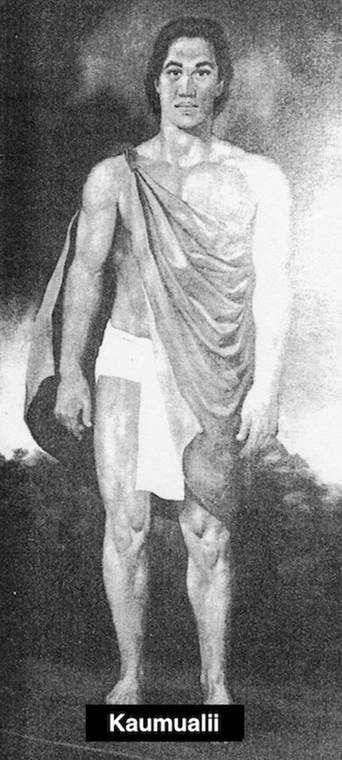In old Hawaii, the fragrant wood of the iliahi tree, called sandalwood, was merely burned as firewood or mixed with coconut oil to perfume kapa.
Yet the Chinese prized sandalwood and, beginning in 1811, they obtained it from American traders at Canton who’d acquired it from Hawaiian chiefs in exchange for Western goods.
The Chinese then made the precious wood into boxes, chests, medicine, perfume and incense, while the Americans took on tea, silk, furniture and China ware for sale in England and America.
On Kauai, King Kaumualii commanded his commoners to cut down iliahi trees, roots and all, and carry the wood to shore and load it aboard ships.
Large forests of iliahi in Kauai’s highlands were felled, while the commoners suffered from exhaustion and cold in the mountains, and having neglected their farms, were forced to eat herbs and ferns. Many died.
Kauai’s sandalwood trade continued until its sandalwood was depleted about 1835.
Although the exact year is uncertain, Yankee trader Captain Wiles and his supercargo met Kaumualii at Waimea for the purpose of trading Western goods for sandalwood sometime between 1811, the year the sandalwood trade began, and 1821, the year Kaumualii was abducted from Kauai by Kamehameha II.
Among the things Kaumualii ordered from Wiles were fancy clothing, furniture, dry-goods, hardware, tools, muskets, gunpowder and, of all things, a battery of artillery.
“Is there anything more? asked the captain.
The king replied, “I have been told by other captains that kings in foreign lands have precious stones and diamonds. I want you to bring me a diamond.”
Neither Wiles nor the supercargo had ever traded in diamonds, and both knew little about them.
“How large?” the captain asked.
“How large do they come?” replied Kaumualli.
All Wiles could say was that they were not very large at all.
Then Kaumualii settled the matter by saying, “ Since diamonds are not large stones, I shall be satisfied with one as large as a coconut.”
It is unknown whether Wiles was ever able to bring Kaumualii a diamond of any size.
•••
Hank Soboleski has been a resident of Kauai since the 1960s. Hank’s love of the island and its history has inspired him, in conjunction with The Garden Island Newspaper, to share the island’s history weekly. The collection of these articles can be found here: https://bit.ly/2IfbxL9 and here https://bit.ly/2STw9gi Hank can be reached at hssgms@gmail.com



The correct tagline reads:Hank Soboleski has been a resident of Kauai since the 1960s. Hank’s love of the island and its history has inspired him, in conjunction with The Garden Island Newspaper, to share the island’s history weekly. The collection of these articles can be found here: https://bit.ly/2IfbxL9 and here https://bit.ly/2STw9gi Hank can be reached at hssgms@gmail.com
Greed and disregard for his people in this sandlewood exploitation proved to be the downfall of King Kaumualii. He should have practiced what his ancestors did in regulating resources so that it never gets depleted, but choose not to do so.
This is the first column I turn to on Sunday mornings. I love reading about the history of Hawaii, Kauai in particular. Good job, Hank!
I’m not an expert on history of Kaua’i, but it’s fair to note that King Kaumuali’i was not Kauai’s King Ali’i during the period of sandalwood trade on Kaua’i beginning in 1810. “Kaumualiʻi was the last independent aliʻi nui of Kauaʻi and Niʻihau before becoming a vassal of Kamehameha I of the unified Kingdom of Hawaiʻi in 1810. He was the 23rd high chief of Kauaʻi, reigning from 1794-1810. In 1810, Kaumualiʻi became Kamehameha’s vassal, and all the islands were united for the first time. Kaumualiʻi continued to serve as Kamehameha’s governor of Kauai. You have a sandalwood trader’s quote, but do you have quote from a native Hawaiian? It’s a one sided written history from those who took advantage of a native people.